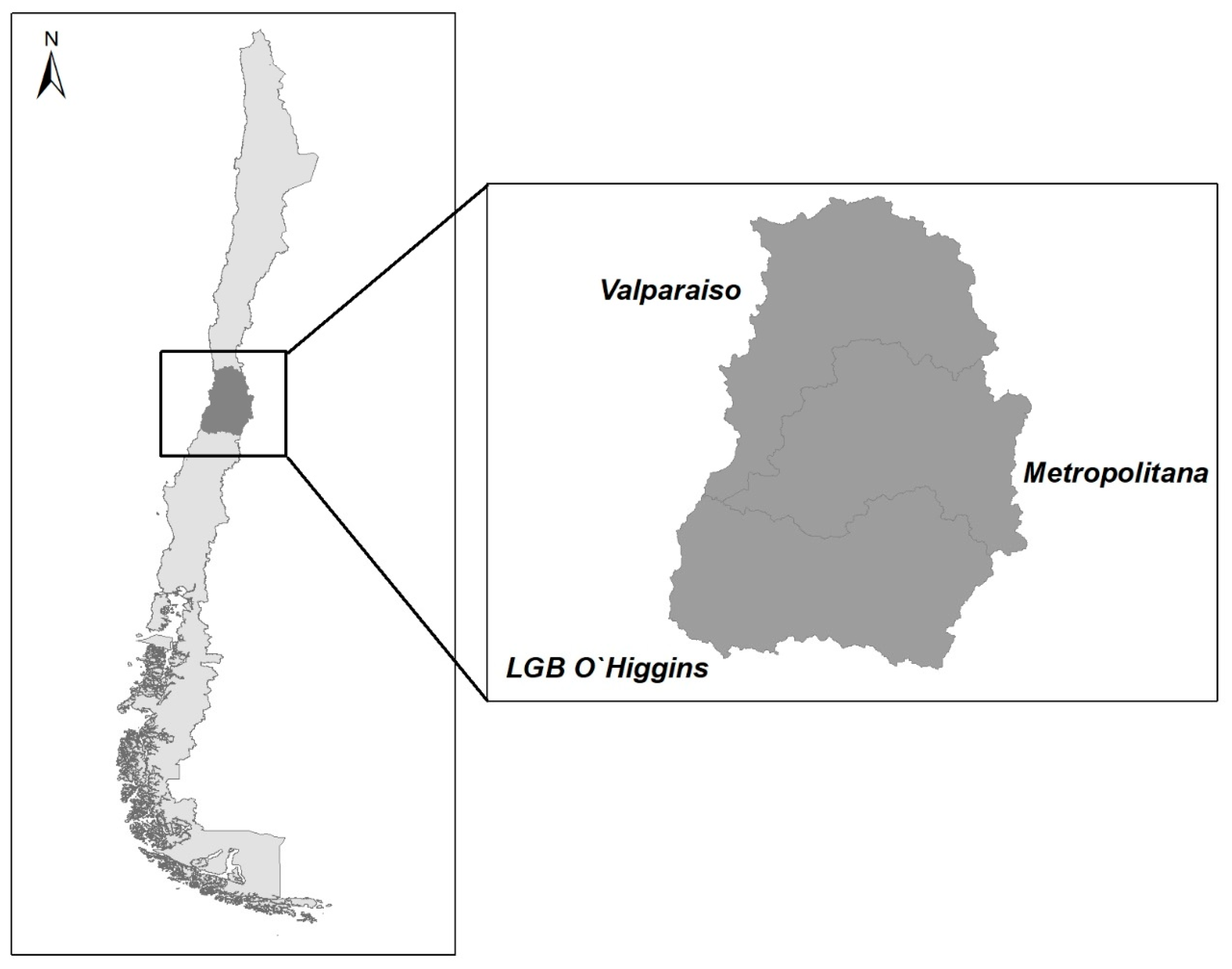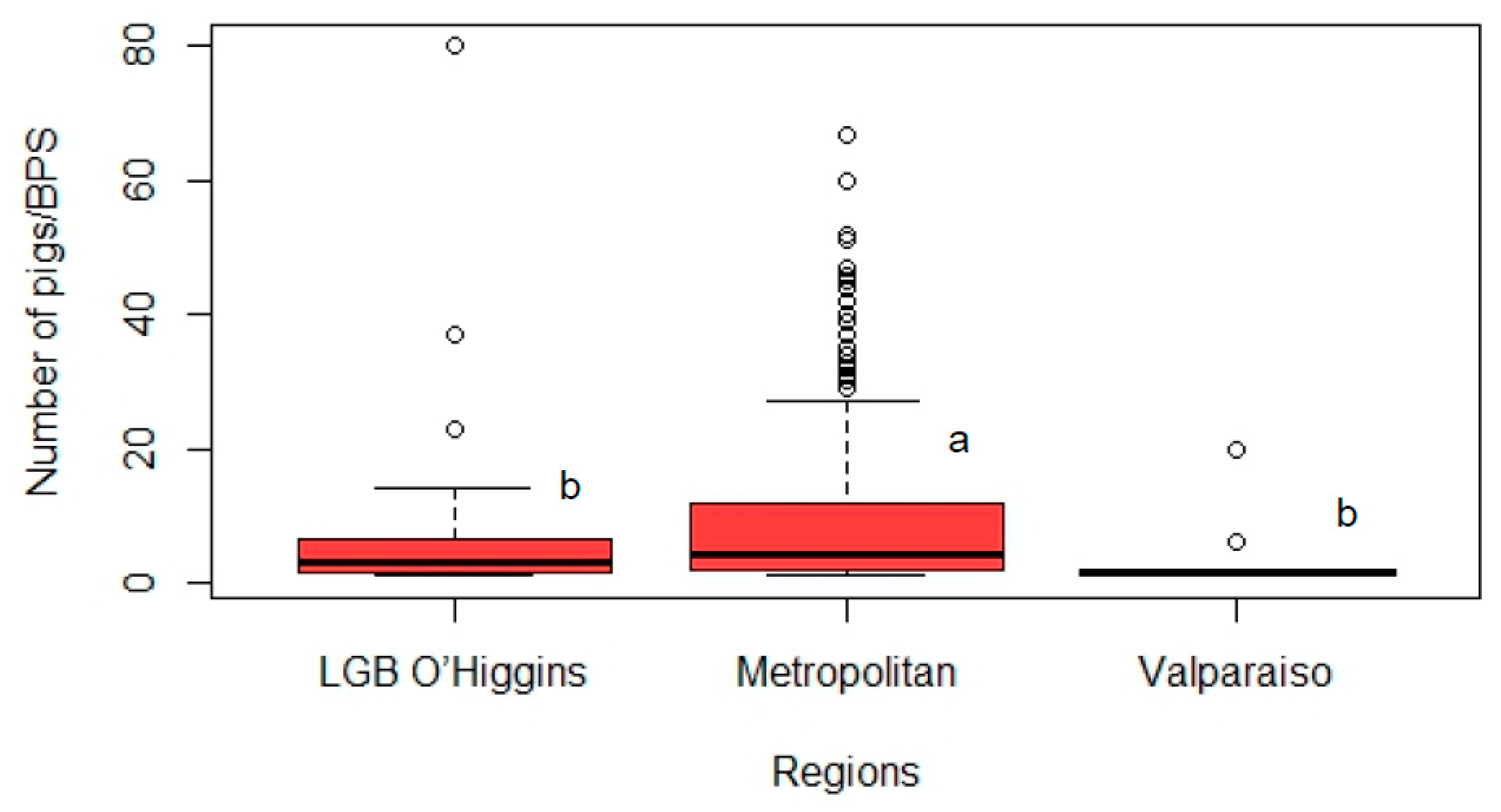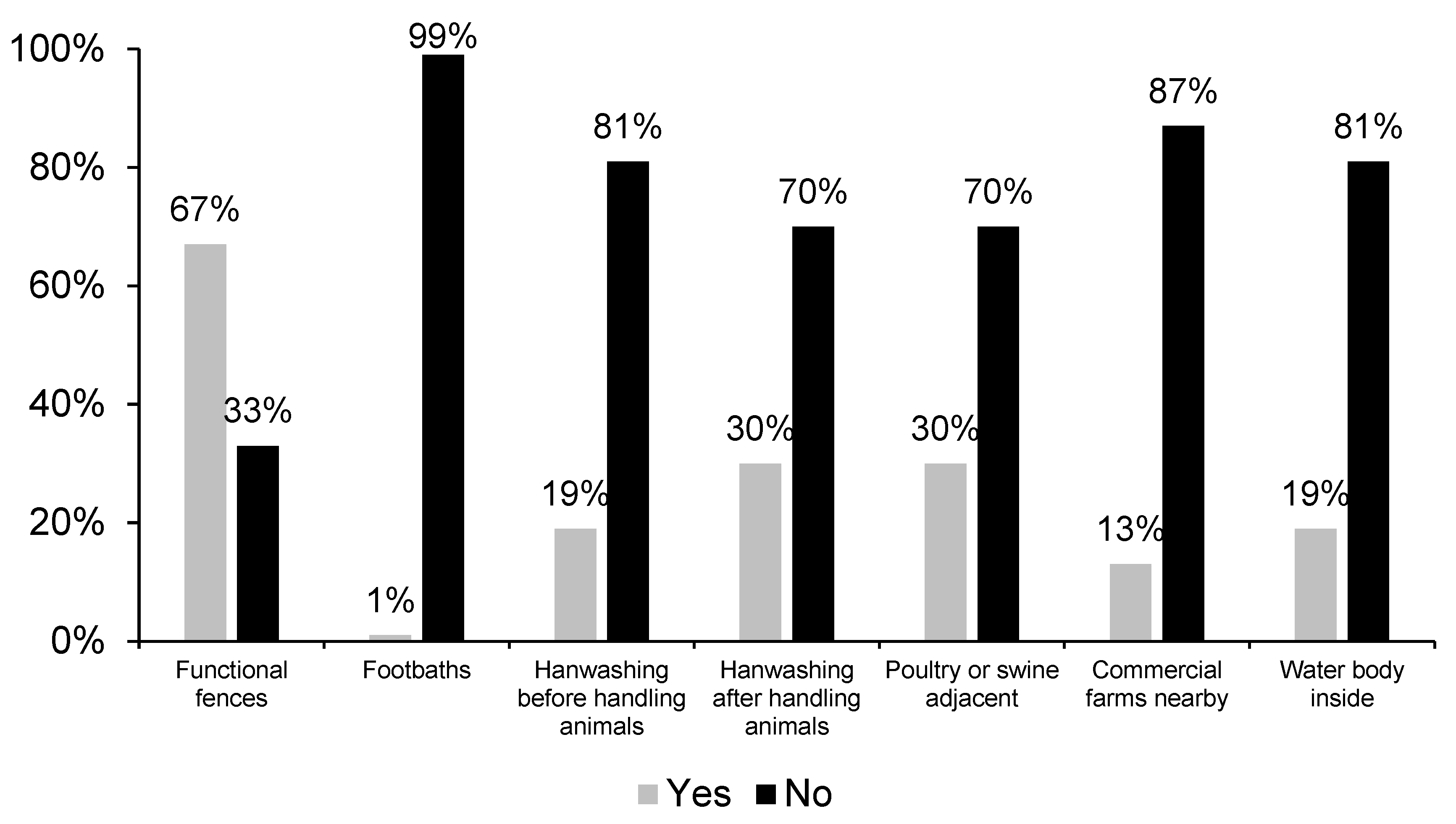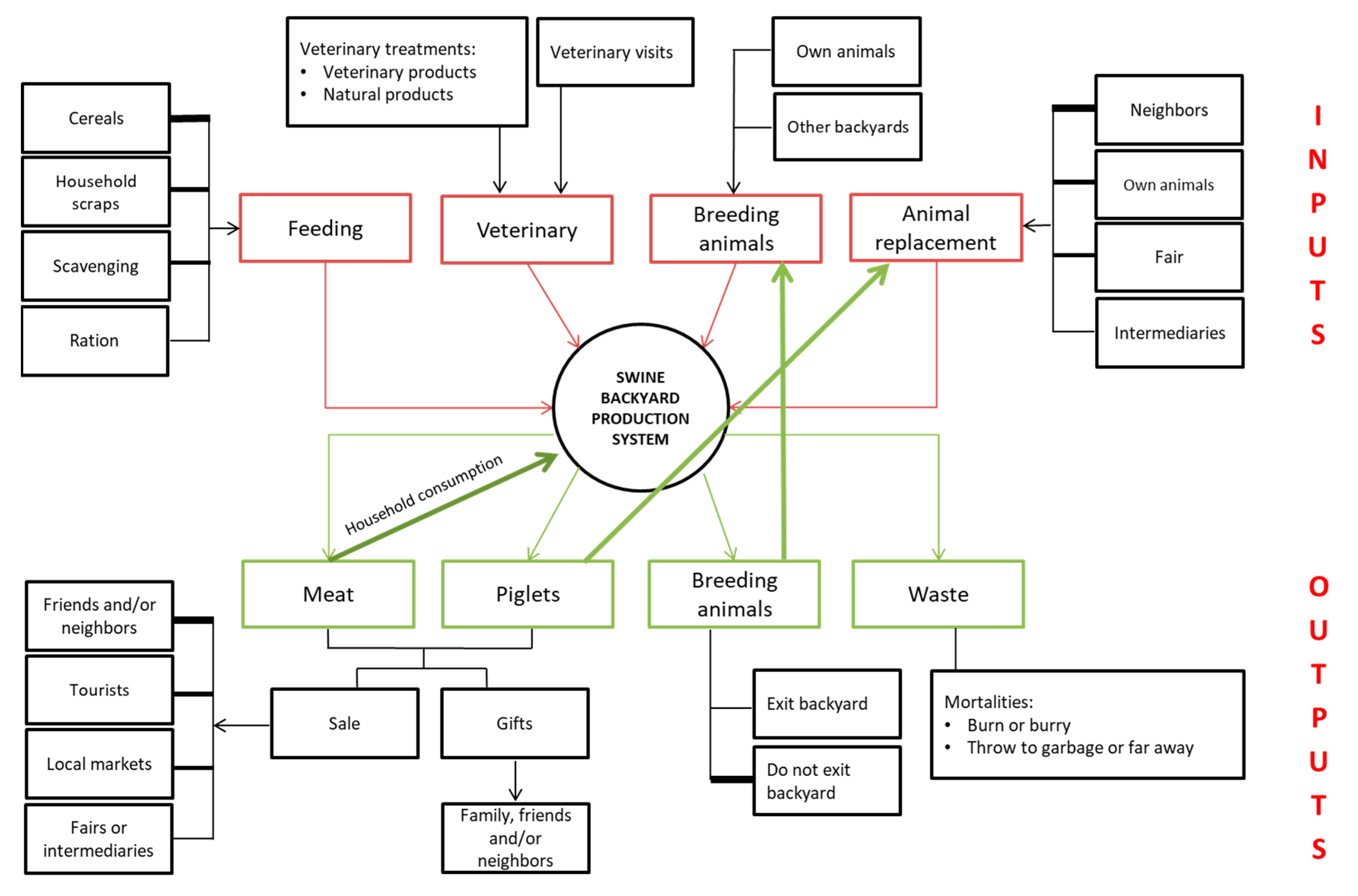Swine Backyard Production Systems in Central Chile: Characterizing Farm Structure, Animal Management, and Production Value Chain
Abstract
Simple Summary
Abstract
1. Introduction
2. Materials and Methods
2.1. Study Area and Study Design
2.2. Farm Data Colection
2.3. Data Analysis
3. Results
3.1. Characterization of Swine BPS: Structure, Animal Handling, and Biosecurity Measures
3.2. Description of Swine BPS Value Chain in Central Chile
4. Discussion
5. Conclusions
Supplementary Materials
Author Contributions
Funding
Institutional Review Board Statement
Informed Consent Statement
Data Availability Statement
Acknowledgments
Conflicts of Interest
References
- Sonaiya, E.B.; Swan, S. Small Scale Poultry Production: Technical Guide; Daya Publishing House: Delhi, India, 2007. [Google Scholar]
- Kryger, K.N.; Thomsen, K.A.; Whyte, M.A.; Dissing, M. Smallholder poultry production–livelihoods, food security and sociocultural significance. In FAO Smallholder Poultry Production Paper; FAO: Rome, Italy, 2010; p. 4. [Google Scholar]
- Salcedo, S.; Guzmán, L. Agricultura Familiar en América Latina y el Caribe: Recomendaciones de Política; FAO: Santiago, Chile, 2014. [Google Scholar]
- INE. Censo Agropecuario y Forestal; Instituto Nacional de Estadística: Santiago, Chile, 2007. [Google Scholar]
- Hamilton-West, C.; Rojas, H.; Pinto, J.; Orozco, J.; Hervé-Claude, L.; Urcelay, S. Characterization of backyard poultry production systems and disease risk in the central zone of Chile. Res. Vet. Sci. 2012, 93, 121–124. [Google Scholar] [CrossRef]
- Bravo-Vasquez, N.; Di Pillo, F.; Lazo, A.; Jiménez-Bluhm, P.; Schultz-Cherry, S.; Hamilton-West, C. Presence of influenza viruses in backyard poultry and swine in El Yali wetland, Chile. Prev. Vet. Med. 2016, 134, 211–215. [Google Scholar] [CrossRef]
- Di Pillo, F.; Anríquez, G.; Alarcón, P.; Jimenez-Bluhm, P.; Galdames, P.; Nieto, V.; Schultz-Cherry, S.; Hamilton-West, C. Backyard poultry production in Chile: Animal health management and contribution to food access in an upper middle-income country. Prev. Vet. Med. 2019, 164, 41–48. [Google Scholar] [CrossRef] [PubMed]
- Bravo-Vasquez, N.; Baumberger, C.; Jimenez-Bluhm, P.; Di Pillo, F.; Lazo, A.; Sanhueza, J.; Schultz-Cherry, S.; Hamilton-West, C. Risk factors and spatial relative risk assessment for influenza A virus in poultry and swine in backyard production systems of central Chile. Vet. Med. Sci. 2020, 6, 518–526. [Google Scholar] [CrossRef] [PubMed]
- Conan, A.; Goutard, F.L.; Sorn, S.; Vong, S. Biosecurity measures for backyard poultry in developing countries: A systematic review. BMC Vet. Res. 2012, 8, 240. [Google Scholar] [CrossRef] [PubMed]
- Iqbal, M. Controlling avian influenza infections: The challenge of the backyard poultry. J. Mol. Genet. Med. Int. J. Biomed. Res. 2009, 3, 119. [Google Scholar] [CrossRef] [PubMed]
- Vandegrift, K.J.; Sokolow, S.; Daszak, P.; Kilpatrick, A.M. Ecology of avian influenza viruses in a changing world. Ann. N. Y. Acad. Sci. 2010, 1195, 113–128. [Google Scholar] [CrossRef] [PubMed]
- Mostafa, A.; Abdelwhab, E.M.; Mettenleiter, T.C.; Pleschka, S. Zoonotic potential of influenza A viruses: A comprehensive overview. Viruses 2018, 10, 497. [Google Scholar] [CrossRef] [PubMed]
- Suzuki, Y.; Ito, T.; Suzuki, T.; Holland, R.E.; Chambers, T.M.; Kiso, M.; Ishida, H.; Kawaoka, Y. Sialic acid species as a determinant of the host range of influenza A viruses. J. Virol. 2000, 74, 11825–11831. [Google Scholar] [CrossRef] [PubMed]
- Jimenez-Bluhm, P.; Di Pillo, F.; Bahl, J.; Osorio, J.; Schultz-Cherry, S.; Hamilton-West, C. Circulation of influenza in backyard productive systems in central Chile and evidence of spillover from wild birds. Prev. Vet. Med. 2018, 153, 1–6. [Google Scholar] [CrossRef] [PubMed]
- Bravo-Vasquez, N.; Karlsson, E.; Jimenez-Bluhm, P.; Meliopoulos, V.; Kaplan, B.; Marvin, S.; Cortez, V.; Freiden, P.; Beck, M.A.; Hamilton-West, C.; et al. Swine influenza virus (H1N2) characterization and transmission in ferrets, Chile. Emerg. Infect. Dis. 2017, 23, 241. [Google Scholar] [CrossRef] [PubMed]
- ALEGRIA-MORAN, R.; Rivera, D.; Toledo, V.; Moreno-Switt, A.I.; Hamilton-West, C. First detection and characterization of Salmonella spp. in poultry and swine raised in backyard production systems in central Chile. Epidemiol. Infect. 2017, 145, 3180–3190. [Google Scholar] [CrossRef] [PubMed]
- Chenais, E.; Boqvist, S.; Lewerin, S.S.; Emanuelson, U.; Ouma, E.; Dione, M.; Aliro, T.; Crafoord, F.; Masembe, C.; Ståhl, K. Knowledge, attitudes and practices related to African swine fever within smallholder pig production in northern Uganda. Transbound. Emerg. Dis. 2017, 64, 101–115. [Google Scholar] [CrossRef] [PubMed]
- Costard, S.; Porphyre, V.; Messad, S.; Rakotondrahanta, S.; Vidon, H.; Roger, F.; Pfeiffer, D. Multivariate analysis of management and biosecurity practices in smallholder pig farms in Madagascar. Prev. Vet. Med. 2009, 92, 199–209. [Google Scholar] [CrossRef] [PubMed]
- Costard, S.; Zagmutt, F.J.; Porphyre, T.; Pfeiffer, D.U. Small-scale pig farmers’ behavior, silent release of African swine fever virus and consequences for disease spread. Sci. Rep. 2015, 5, 17074. [Google Scholar] [CrossRef] [PubMed]
- Gogin, A.; Gerasimov, V.; Malogolovkin, A.; Kolbasov, D. African swine fever in the North Caucasus region and the Russian Federation in years 2007–2012. Virus Res. 2013, 173, 198–203. [Google Scholar] [CrossRef] [PubMed]
- Gaudreault, N.N.; Madden, D.W.; Wilson, W.C.; Trujillo, J.D.; Richt, J.A. African swine fever virus: An emerging DNA arbovirus. Front. Vet. Sci. 2020, 7, 215. [Google Scholar] [CrossRef] [PubMed]
- Paulino-Ramirez, R.; Jimenez, J.A. Food security and research agenda in african swine fever virus: A new arbovirus threat in the dominican republic. Int. Am. J. Med. Health 2021, 4, 1–3. [Google Scholar] [CrossRef]
- WOAH. African Swine Ferver (ASF) Situation Report 05 Nov 2021–18 Nov 2021; World Organisation for Animal Health: Paris, France, 2021. [Google Scholar]
- WOAH. Recognition of the Classical Swine Fever Status of Members. Resolution No. 18. 89th General Session; World Organisation for Animal Health: Paris, France, 2022. [Google Scholar]
- Neumann, G.; Noda, T.; Kawaoka, Y. Emergence and pandemic potential of swine-origin H1N1 influenza virus. Nature 2009, 459, 931–939. [Google Scholar] [CrossRef] [PubMed]
- Trovão, N.S.; Nelson, M.I. When pigs fly: Pandemic influenza enters the 21st century. PLoS Pathog. 2020, 16, e1008259. [Google Scholar] [CrossRef] [PubMed]




| Variable | Categories | Number | Percentage |
|---|---|---|---|
| Main objective of swine breeding | Household consumption | 157 | 44% |
| Sale | 31 | 9% | |
| Household consumption and sale | 163 | 46% | |
| No product obtained | 3 | 1% | |
| Total | 354 | ||
| Years of swine rearing | Less than 2 years | 133 | 39% |
| Between 2 and 10 years | 98 | 28% | |
| More than 10 years | 113 | 33% | |
| Total | 344 | ||
| Confinement | Free range | 15 | 4% |
| Mixed | 69 | 20% | |
| Permanent | 268 | 76% | |
| Total | 352 | ||
| Swine management | Woman in charge | 74 | 21% |
| Man in charge | 200 | 57% | |
| Family in charge | 75 | 22% | |
| Total | 349 | ||
| Veterinary care | No veterinary care | 272 | 78% |
| Veterinary care at least once a year | 76 | 22% | |
| Total | 348 | ||
| Feeding | Grains | 58 | 17% |
| Swine feed | 15 | 5% | |
| Scavenging and household scrap | 21 | 6% | |
| Mixed | 241 | 72% | |
| Total | 335 | ||
| Water | Potable sources | 303 | 87% |
| Environmental sources | 47 | 13% | |
| Total | 350 | ||
| Mortalities handling | Bury | 208 | 63% |
| Burn | 28 | 9% | |
| Throw into the garbage | 14 | 4% | |
| Throw far away | 17 | 5% | |
| Household consumption or sale | 4 | 1% | |
| Nothing | 8 | 3% | |
| Mixed | 24 | 7% | |
| No mortalities reported | 25 | 8% | |
| Total | 328 | ||
| Movement of swine in or out of the BPS | Yes | 39 | 16% |
| No | 202 | 84% | |
| Total | 241 | ||
| Replacement | Own offspring | 123 | 37% |
| Neighbors | 146 | 43% | |
| Own offspring and neighbors | 32 | 10% | |
| Markets or other | 21 | 6% | |
| Mixed | 15 | 4% | |
| Total | 337 |
| BPS Characterization Variables | Functional Fences | p-Value | Handwashing before and after Animal Handling | p-Value | ||
|---|---|---|---|---|---|---|
| Yes; n (%) | No; n (%) | Yes; n (%) | No; n (%) | |||
| Main objective of swine breeding | 0.106 | 0.593 | ||||
| Household consumption | 109 (46%) | 48 (43%) | 24 (40%) | 133 (46%) | ||
| Sale | 25 (10%) | 5 (4%) | 7 (12%) | 23 (8%) | ||
| Household consumption and sale | 104 (44%) | 58 (51%) | 29 (48%) | 132 (45%) | ||
| No product obtained | 1 (0%) | 2 (2%) | 0 (0%) | 3 (1%) | ||
| Total | 239 | 113 | 60 | 291 | ||
| Years of swine rearing | <0.001 | 0.557 | ||||
| Less than 2 years | 108 (46%) | 23 (22%) | 26 (44%) | 105 (37%) | ||
| Between 2 and 10 years | 69 (29%) | 29 (27%) | 14 (24%) | 83 (30%) | ||
| More than 10 years | 59 (25%) | 54 (51%) | 19 (32%) | 94 (33%) | ||
| Total | 236 | 106 | 59 | 282 | ||
| Swine management | <0.001 | 0.363 | ||||
| Man in charge | 155 (65%) | 44 (40%) | 34 (58%) | 165 (57%) | ||
| Woman in charge | 49 (21%) | 24 (22%) | 9 (15%) | 63 (22%) | ||
| Family in charge | 34 (14%) | 41 (38%) | 16 (27%) | 59 (21%) | ||
| Total | 238 | 109 | 59 | 287 | ||
| Pigs/BPS, median (range) | 3.5 (1; 67) | 4.0 (1; 80) | 0.683 | 3.0 (1; 60) | 4.0 (1; 80) | 0.966 |
Disclaimer/Publisher’s Note: The statements, opinions and data contained in all publications are solely those of the individual author(s) and contributor(s) and not of MDPI and/or the editor(s). MDPI and/or the editor(s) disclaim responsibility for any injury to people or property resulting from any ideas, methods, instructions or products referred to in the content. |
© 2023 by the authors. Licensee MDPI, Basel, Switzerland. This article is an open access article distributed under the terms and conditions of the Creative Commons Attribution (CC BY) license (https://creativecommons.org/licenses/by/4.0/).
Share and Cite
Baumberger, C.; Di Pillo, F.; Galdames, P.; Oyarzun, C.; Marambio, V.; Jimenez-Bluhm, P.; Hamilton-West, C. Swine Backyard Production Systems in Central Chile: Characterizing Farm Structure, Animal Management, and Production Value Chain. Animals 2023, 13, 2000. https://doi.org/10.3390/ani13122000
Baumberger C, Di Pillo F, Galdames P, Oyarzun C, Marambio V, Jimenez-Bluhm P, Hamilton-West C. Swine Backyard Production Systems in Central Chile: Characterizing Farm Structure, Animal Management, and Production Value Chain. Animals. 2023; 13(12):2000. https://doi.org/10.3390/ani13122000
Chicago/Turabian StyleBaumberger, Cecilia, Francisca Di Pillo, Pablo Galdames, Cristobal Oyarzun, Victor Marambio, Pedro Jimenez-Bluhm, and Christopher Hamilton-West. 2023. "Swine Backyard Production Systems in Central Chile: Characterizing Farm Structure, Animal Management, and Production Value Chain" Animals 13, no. 12: 2000. https://doi.org/10.3390/ani13122000
APA StyleBaumberger, C., Di Pillo, F., Galdames, P., Oyarzun, C., Marambio, V., Jimenez-Bluhm, P., & Hamilton-West, C. (2023). Swine Backyard Production Systems in Central Chile: Characterizing Farm Structure, Animal Management, and Production Value Chain. Animals, 13(12), 2000. https://doi.org/10.3390/ani13122000






